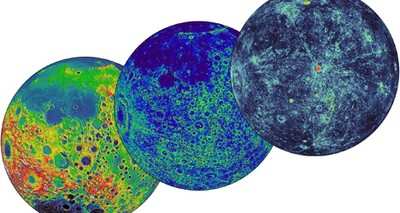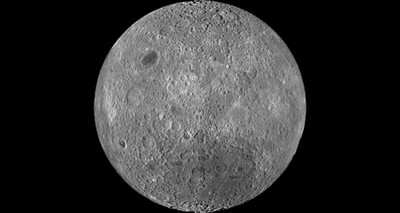Agency Says New Maps And Images Are "Striking"
NASA's Lunar Reconnaissance Orbiter (LRO) team released the
final set of data Tuesday from the mission's exploration phase
along with the first measurements from its new life as a science
satellite. With this fifth release of data, striking new images and
maps have been added to the already comprehensive collection of raw
lunar data and high-level products, including mosaic images, that
LRO has made possible. The spacecraft's seven instruments delivered
more than 192 terabytes of data with an unprecedented level of
detail. It would take approximately 41,000 typical DVDs to hold the
new LRO data set.

NASA Image
"The release of such a comprehensive and rich collection of
data, maps and images reinforces the tremendous success we have had
with LRO in the Exploration Systems Mission Directorate and with
lunar science," said Michael Wargo, chief lunar scientist of the
Exploration Systems Mission Directorate at NASA Headquarters in
Washington.
Among the latest products is a global map with a resolution of
100 meters per pixel from the Lunar Reconnaissance Orbiter Camera
(LROC). To enhance the topography of the moon, this map was made
from images collected when the sun angle was low on the horizon.
Armchair astronauts can zoom in to full resolution with any of the
mosaics—quite a feat considering that each is 34,748 pixels
by 34,748 pixels, or approximately 1.1 gigabytes. "Because the moon
is so close and because we have a dedicated ground station, we are
able to bring back as much data from LRO as from all the other
planetary missions combined," said LRO Project Scientist Richard
Vondrak of NASA's Goddard Space Flight Center in Greenbelt, Md.
LRO's Diviner Lunar Radiometer Experiment is providing new data
relating to the moon's surface. These include maps of visual and
infrared brightness, temperature, rock abundance, nighttime soil
temperature and surface mineralogy. The data are in the form of
more than 1700 digital maps at a range of resolutions that can be
overlaid easily on other lunar data sets. The Lyman-Alpha Mapping
Project, which collects information to help identify surface
water-ice deposits, especially in permanently-shadowed regions of
the moon, also has new data. This release includes new maps of
far-ultraviolet (FUV) brightness, albedo and water-ice data as well
as instrument exposure, illumination and other conditions.

NASA Image
As a complement to the high-resolution digital elevation maps,
representing 3.4 billion measurements already released by the Lunar
Orbiter Laser Altimeter team, the group is delivering new maps of
slope, roughness and illumination conditions. New maps from the
Lunar Exploration Neutron Detector, and the latest data from the
Cosmic Ray Telescope for the Effects of Radiation and the Miniature
Radio Frequency instruments, also are featured. "All these global
maps and other data are available at a very high resolution --
that's what makes this release exciting," said Goddard's John
Keller, the LRO deputy project scientist. "With this valuable
collection, researchers worldwide are getting the best view of the
moon they have ever had."
The complete data set contains the raw information and
high-level products such as mosaic images and maps. The data set
also includes more than 300,000 calibrated data records released by
LROC. All of the final records from the exploration phase, which
lasted from Sept. 15, 2009 through Sept. 15, 2010, are available
through several of the Planetary Data System nodes and the LROC
website.
 ANN's Daily Aero-Linx (04.13.24)
ANN's Daily Aero-Linx (04.13.24) ANN's Daily Aero-Term (04.13.24): Beyond Visual Line Of Sight (BVLOS)
ANN's Daily Aero-Term (04.13.24): Beyond Visual Line Of Sight (BVLOS) Airborne 04.09.24: SnF24!, Piper-DeltaHawk!, Fisher Update, Junkers
Airborne 04.09.24: SnF24!, Piper-DeltaHawk!, Fisher Update, Junkers Aero-News: Quote of the Day (04.14.24)
Aero-News: Quote of the Day (04.14.24) ANN's Daily Aero-Term (04.14.24): Maximum Authorized Altitude
ANN's Daily Aero-Term (04.14.24): Maximum Authorized Altitude




